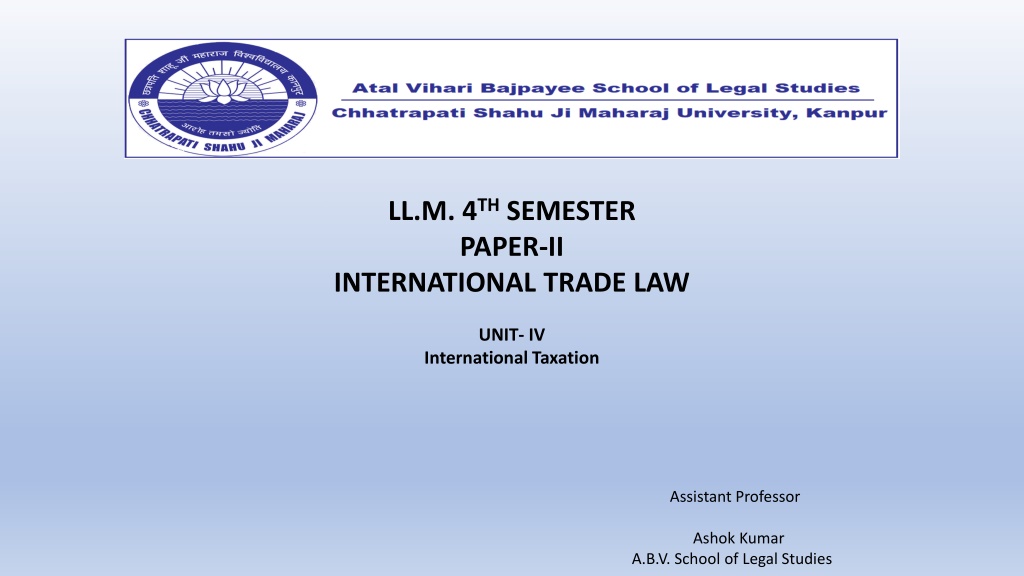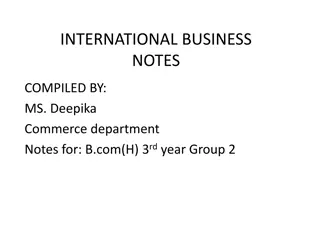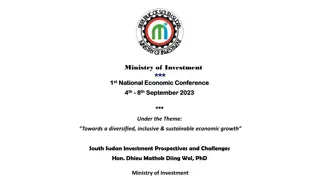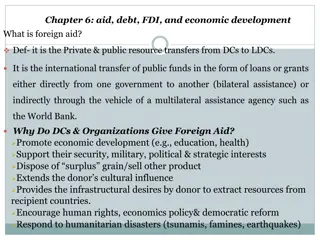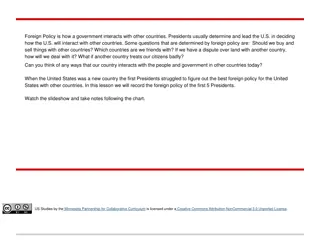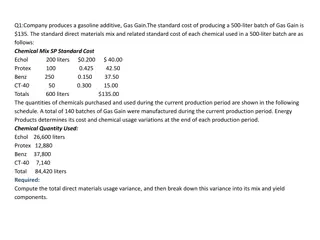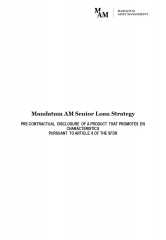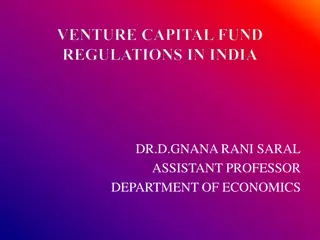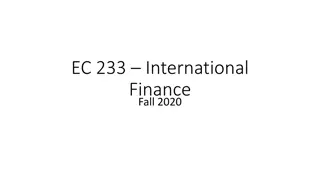Trends in Outward Foreign Direct Investment from India
Outbound investments from India have seen significant growth in magnitude and diversification over the last decade. Indian companies are increasingly investing in overseas markets, particularly in countries offering tax benefits. The shift in investment trends has led to increased mergers and acquisitions, providing companies with access to new markets and technologies. Key investments include Tata Steel, Wipro, Tata Power, Reliance Industries, and Interglobe Enterprises.
- Foreign Direct Investment
- Indian Companies
- Overseas Investments
- Investment Trends
- Mergers and Acquisitions
Download Presentation

Please find below an Image/Link to download the presentation.
The content on the website is provided AS IS for your information and personal use only. It may not be sold, licensed, or shared on other websites without obtaining consent from the author. Download presentation by click this link. If you encounter any issues during the download, it is possible that the publisher has removed the file from their server.
E N D
Presentation Transcript
LL.M. 4TH SEMESTER PAPER-II INTERNATIONAL TRADE LAW UNIT- IV International Taxation Assistant Professor A.B.V. School of Legal Studies Ashok Kumar
FDI from India to other countries FDI from India to other countries Outward direct investment, also called direct investment abroad, includes assets and liabilities transferred between resident direct investors and their direct investment enterprises. It also covers transfers of assets and liabilities between resident and nonresident fellow enterprises, if the ultimate controlling parent is resident. Outward direct investment is also called direct investment abroad. Data on FDI flows are presented on net bases (capital transactions' credits less debits between direct investors and their foreign affiliates). Net decreases in assets or net increases in liabilities are recorded as credits, while net increases in assets or net decreases in liabilities are recorded as debits. Hence, FDI flows with a negative sign indicate that at least one of the components of FDI is negative and not offset by positive amounts of the remaining components. These are instances of reverse investment or disinvestment.
Introduction Outbound investments from India have undergone a considerable change, not only in terms of magnitude but also in terms of geographical spread and sectorial composition. Analysis of the trends in direct investment over the last decade reveals that while investment flows, both inward and outward, were rather muted during the early part of the decade, they gained momentum during the latter half. There has been a perceptible shift in Overseas Investment Destination (OID) in last decade or so. While in the first half, overseas investments were directed to resource rich countries such as Australia, UAE, and Sudan, in the latter half, OID was channeled into countries providing higher tax benefits such as Mauritius, Singapore, British Virgin Islands, and the Netherlands. Indian firms invest in foreign shores primarily through mergers and acquisition (M&A). With rising M&A activity, companies will get direct access to newer and more extensive markets and better technologies, which would enable them to increase their customer base and achieve a global reach. Market size According to the Department of Economic Affairs, India s outward foreign direct investment (OFDI) stood at US$ 1,554.91 million in August 2021 vs. US$ 2,213.48 million in July 2021 .
Investments/Developments Some of the major overseas investments by Indian companies were: Foreign portfolio investors (FPIs) invested US$ 2.5 billion in India in August 2021. As per RBI s (Reserve Bank of India) data, in June 2021, India Inc.'s overseas direct investment stood at US$ 2.8 billion, registering a 2X YoY growth. Of the total investments, loans accounted for US$ 1.21 billion, equity capital accounted for US$ 426.84 million and issuance of guarantees stood at US$ 1.17 billion. The key investments are as follows: Tata Steel invested US$ 1 billion in a wholly owned subsidiary in Singapore. Wipro invested US$ 787.5 million in a fully owned unit in the US. Tata Power invested US$ 131.25 million in a wholly owned unit in Mauritius. Reliance Industries invested US$ 56 million in agriculture and mining-based wholly owned subsidiary in Singapore. Interglobe Enterprises invested US$ 51.5 million in a joint venture in the UK.
ONGC Videsh Ltd. invested US$ 48.31 million in a joint venture in Mozambique. Paharpur Cooling Towers invested US$ 48 million in a wholly owned subsidiary in Singapore. Tata Communications invested US$ 50 million in a wholly owned subsidiary in Singapore. ONGC Videsh invested US$ 48.70 million in a joint venture in Russia. WNS Global Services invested US$ 45 million in a joint venture in the Netherlands. In September 2021, Serum Institute of India announced to invest US$ 68 million in Oxford Biomedica, a UK-based vaccine manufacturer, to boost manufacturing of COVID-19 vaccine. In May 2021, the Serum Institute of India announced plan to invest GBP 240 million (US$ 332.38 million) in the UK to expand its vaccine business and open a new sales office. In May 2021, Reliance Jio Infocomm (Jio) announced that it is deploying submarine cable systems, connecting India to Singapore and beyond, to meet the rising data demand.
Government Initiatives In the Union Budget 2021-22, the foreign direct investment (FDI) cap has been increased to 74%, and other changes to the insurance sector have been proposed to enable foreign ownership and control with safeguards. Other amendment proposes that the majority of board members and key management personnel would be resident Indians, with at least 50% directors being independent directors, and a defined percentage of income set aside as a general reserve under the new structure. According to experts, the proposed reforms could pave the way for private equity funds to enter the insurance sector. In September 2021, Export-Import Bank of India announced to extend US$ 40 million (~ Rs. 292 crore) worth of line of credit (LOC) to the Maldives government to offer finance for the establishment of sports infrastructure. In June 2021, Export-Import Bank of India (Exim Bank) announced that it extended a line of credit (LOC) worth US$ 100 million to the Sri Lankan government to fund projects pertaining to solar energy. In September 2021, Union Cabinet approved an agreement between Portugal and India on the employment of Indian citizens to work in the Portuguese Republic. In June 2021, India launched a new trilateral partnership with Italy and Japan for Indo-Pacific stability.
In June 2021, India launched a new trilateral partnership with Italy and Japan for Indo-Pacific stability. In November 2020, the Securities and Exchange Board of India (Sebi) expanded the foreign investment cap for mutual funds to US$ 600 million from US$ 300 million, thus capping the total industry limit to US$ 7 billion. To boost domestic investments and reduce outflows, in August 2020, Mr. Piyush Goyal, Commerce and Industry Minister, asked auto manufacturers to find solutions to reduce royalty payments to foreign parent companies for use of technology or brand names The RBI, encouraged by adequate forex reserves, has relaxed the norms for domestic companies investing abroad by doing away with the ceiling for raising funds through pledge of shares, domestic and overseas assets. In addition to JVs and wholly owned subsidiaries, the central bank has announced similar concessions for pledging of shares in case of step- down subsidiary. The RBI also liberalised/ rationalised guidelines for foreign investment by Indian companies. It raised the annual overseas investment ceiling to US$ 125,000 from US$ 75,000 to establish JV and wholly owned subsidiaries. The Government's supportive policy regime complemented by India Inc. s experimental outlook could lead an upward trend in OFDI in future.
Road ahead Overseas investment is one of the foremost steps to enter the global marketplace and in recent times, India has taken necessary steps to make its presence felt in the global arena. Investment outlook in some of the overseas market looks positive. For instance, the Indian industry is projected to increase its revenue from Africa. IT services, infrastructure, agriculture, pharmaceuticals and consumer goods are vital to India boosting Africa revenue to US$ 160 billion by 2025 as per McKinsey & Co. According to UK government s new data published in June 2020, India has maintained its spot as the second-largest source of foreign direct investment (FDI) for the UK. Indian businesses have invested in ~99 projects in the UK and generated > 4,800 jobs. In another development, the Ministry of External Affairs has initiated a move to set up a direct sea and air link between India and the Latin American region as Indian corporates plan significant investments in the mining, oil, IT and pharmaceutical sectors in that region. Overseas investment by India companies is expected to increase, backed by stable market conditions and considerable impact of the investment on local economies.
